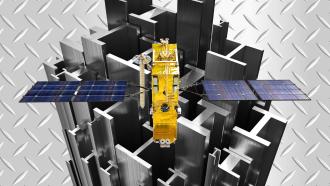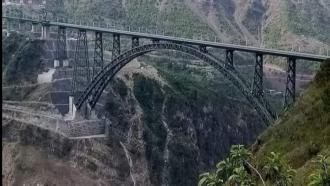Photo: Siddharth Kankaria/ Research Matters
The recent launch of PSLV-C37 with 104 satellites has been widely acknowledged and ISRO has been receiving all the accolades for being successful uninterruptedly. Almost every news media in India and abroad praised this event and wishes for its achievements came in from almost all quarters. With its humble beginnings in the seventies mostly focusing on the satellites space launch vehicles, the Indian Space Research Organisation (ISRO) has come a long way to taking up actual moonshot projects with Chandrayaan - 1 and Mangalyan – 1. Viewing all these at one lakh feet above, the realisation of what is ISRO itself - is beyond such a moonshot, a mega science project.
The launch put into orbit 104 satellites, with three from India, 96 from USA, one each from The Netherlands, Switzerland, Israel, Kazaksthan and UAE. It is interesting to note that of the total 1378 kg payload including the weight of all satellites, it was Cartosat-2 that weighed most with 714 kg. The rest including two more ISRO’s Nano Satellites as technology demonstration satellites, INS-1 and INS 2 weighed 8.4 kg and 9.7 kg respectively. The remaining 101 satellites weighed anywhere between 1.1 kg to 4.7 kg each. The majority ones that were launched by ISRO weighing less than 10 kg fall under a new breed of satellites referred to as Nano Satellites, one of the reasons aiding ISRO to notch up this record number of satellites launched. Nevertheless, one cannot undermine the advances in sciences and precision in engineering that has made this possible.
Given this stupendous success, it is worthwhile to reflect briefly on its humble beginnings and the key ingredients that has shaped ISRO what it is today. Perhaps, also noting that ISRO should now embrace itself to face more challenges for it be on the competitive trend it may have to shed any complacency. More than ISRO gearing up to it, it is key that the policy makers shape the rules of this game to make it more competitive and geared up to take on more challenging tasks.
The success of ISRO has deep roots in harnessing the science that has been carried out largely at the Indian Institute of Science without much fanfare. On Science Day, that is observed on February 28 of every year after the day Sir CV Raman discovered the Raman Effect, it is befitting to reflect on what aspects of science and engineering has shaped ISRO to be what it is today.
ISRO’s success can be attributed at least three key scientific and engineering domains that has helped shape the space program: the aerospace engineering, materials science, and electrical communications engineering.
The Aerospace Engineering department at IISc is the oldest such department in the country established in 1942 for supporting the then Hindustan Aeronautics Limited (HAL) in Bengaluru. The required capabilities for designing a launch vehicle was known and accessible. Following the support of Aerospace has been the complimentary support from Materials Engineering (then known as Metallurgy) that was established in 1945. The Materials Engineering aided in developing the outer cover and appropriate materials and composites to be used in the launch vehicles and satellites that could tolerate extreme temperatures in its role as the protective cover. The Electrical Communications Engineering Department was carved out of the Electrical Technology Department in 1946 at IISc. The science and engineering here aided in ensuring that all the communications from the ground control stations and the satellites were in place.
All the three departments at IISc played a key role in ensuring the right translation of research carried out in to these launch vehicles and satellites. More importantly, these departments have trained thousands of engineers and scientists who have led and shaped different facets of the Indian Space program. Research carried out at IISc are still being used and applied in different aspects across different entities of ISRO.
Apart from advancing science and engineering, which helped shape the space program, there have been numerous other domains that have greatly benefitted from this. Notably, satellite communication through INSAT series, that has provided the much-needed self-reliance for meteorology, telecommunications and broadcasting. This has resulted in enhancing weather monitoring and forecasts, widespread coverage of television and radio, and pervasive adoption of mobile phone based communication systems which has become ubiquitous across the nation. In many ways, the boom of television and communication in the country is also responsible because of what ISRO has delivered.
Tangible benefits in telecommunication and meteorology aside, there have been significant efforts in understanding our earth systems and space too. A host of remote sensing satellites have indeed been aiding in better monitoring of land systems. More than the earth system itself, our understanding of space, through a host of astronomy and astrophysics programs that are pursued at Indian Institute of Science, Indian Institute of Astrophysics and Raman Research Institute are giving us newer understanding of the ever-expanding space. The Astrosat that was recently launched is a shot in the arm in this direction. The on-board measurement systems on Chandrayaan-1, Mangalayaan-1 and Astrosat have indeed enhanced our understanding of the outer space more than ever
The organisational design and techno-managerial approach employed at ISRO has also been crucial in all its success, despite being a public sector organisation. One of the reasons also ascribed to its success is that the organisation has been typically headed by a Chairperson, ISRO and Secretary of Department of Space by an insider than a bureaucrat. While this is also true for some of our scientific establishments like the Department of Biotechnology, Department of Science and Technology and the Ministry of Earth Sciences, Department of Space reports directly to the PMO and thus enjoys a greater support and relatively greater autonomy with lesser interference from the bureaucracy. What will be of interest to take leaf out of ISRO is how we could shape a host of such organisations in the country in similar way.
Moving on, it is crucial how policy changes can keep ISRO and a host of Indian enterprises to lead the space program in the global arena. As it stands, ISRO is the only organisation allowed to launch space vehicles in the country. This is a monopoly and perhaps with private participation, it can further boost the entire research and innovation in the space segment and may very well position India to lay a significant claim on the estimated US $ 3 billion market for launching nano and micro satellites in the next three years globally. With ISRO alone, it can be a daunting task but with the right private participation and regulation it can further boost more jobs and give stimulus to the manufacturing industry in the country.
Beyond launch vehicles, the same could be extended to the satellites too. We have seen Edusat and a host of other satellites designed by universities in India, but there has not been visible private participation in this arena. With regard to accessing high resolution satellite remote sensing data, an Indian citizen still has to rely on the National Remote Sensing Centre, an arm of ISRO – the only agency authorised to obtain them. While in the US, besides the remote sensing satellites of NASA, there are a host of private operators all well regulated by the US Department of Defense. Some of the notable such products by private players are Quickbird at 61 cm resolution, IKONOS at 1 m, etc. Only notable private entrants to this arena from India are Team Indus and Astrome. Team Indus is building a privately funded spacecraft capable of soft landing on the Moon. Astrome, a recent startup with plans to beam internet through satellites, is building its own satellites while still relying on ISRO for launching them.
The time is ripe for the policy makers to open the space segment for private participation and ride on the success of ISRO and all the available talent to take India forward for several decades to come. Beyond moonshots, India should now set its eyes to the next level.

























